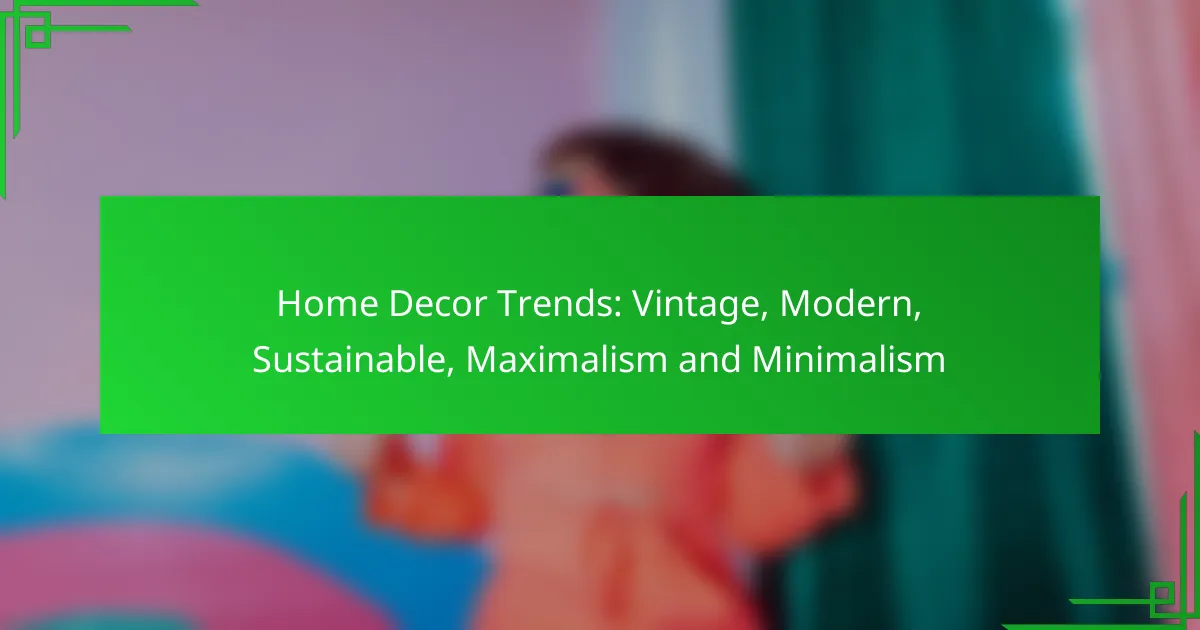In 2023, home decor trends are embracing a diverse mix of vintage charm, modern minimalism, and sustainable practices, alongside both maximalist and minimalist styles. This eclectic approach allows homeowners to express their individuality while prioritizing comfort and environmental awareness in their living spaces.

What are the top home decor trends in 2023?
The top home decor trends in 2023 include a blend of vintage styles, modern minimalism, sustainable materials, and both maximalist and minimalist approaches. These trends reflect a growing desire for personal expression, environmental consciousness, and comfort in living spaces.
Vintage decor revival
The vintage decor revival emphasizes the charm of past eras, often incorporating antique furniture, retro patterns, and nostalgic color palettes. This trend encourages mixing old pieces with contemporary items to create a unique aesthetic that tells a story.
When selecting vintage decor, consider sourcing from local thrift stores, flea markets, or online marketplaces. Look for items that resonate with your personal style, whether it’s mid-century modern, art deco, or rustic farmhouse.
Modern minimalist aesthetics
Modern minimalist aesthetics focus on simplicity, functionality, and clean lines, creating serene and uncluttered spaces. This trend prioritizes quality over quantity, often featuring a neutral color palette and carefully chosen furniture that serves multiple purposes.
To achieve a minimalist look, declutter your space by removing non-essential items and opting for furniture with sleek designs. Incorporate natural light and open spaces to enhance the feeling of tranquility.
Sustainable materials usage
Sustainable materials usage is increasingly important in home decor, with a focus on eco-friendly products that minimize environmental impact. This trend includes using reclaimed wood, recycled metals, and organic textiles to create stylish yet responsible interiors.
When choosing sustainable materials, look for certifications such as FSC (Forest Stewardship Council) for wood products or GOTS (Global Organic Textile Standard) for fabrics. Investing in these materials not only benefits the planet but also adds a unique character to your home.
Maximalism in urban spaces
Maximalism in urban spaces embraces bold colors, eclectic patterns, and a mix of textures to create vibrant and personalized environments. This trend allows for self-expression through layering various decor elements, making each space feel dynamic and lively.
To incorporate maximalism, consider combining different styles, such as vintage and contemporary, and using statement pieces like oversized art or colorful rugs. Be mindful of balance; too much can overwhelm a space, so select focal points that draw the eye.
Minimalism in suburban homes
Minimalism in suburban homes emphasizes simplicity and functionality, often featuring open floor plans and a limited color palette. This approach creates a peaceful atmosphere, ideal for families seeking a retreat from the hustle and bustle of city life.
To implement minimalism in your suburban home, focus on essential furniture pieces and avoid overcrowding rooms with decor. Use storage solutions that keep items out of sight, maintaining a clean and organized environment that promotes relaxation.

How to incorporate vintage decor into your home?
Incorporating vintage decor into your home involves blending unique, old-fashioned elements with your existing style. This can create a warm, inviting atmosphere that tells a story and adds character to your space.
Thrift store finds
Thrift stores are treasure troves for vintage decor. Look for items like old picture frames, unique vases, or retro kitchenware that can add charm to your home. When shopping, consider the condition and potential for upcycling; a little creativity can transform a worn piece into a standout feature.
Set a budget before you shop, as prices can vary widely. Many thrift stores offer items for just a few dollars, making it easy to experiment without breaking the bank. Don’t hesitate to visit multiple stores to find the best selections.
Antique furniture restoration
Restoring antique furniture can breathe new life into your home while preserving its history. Start by assessing the piece’s condition and determining what repairs are necessary, such as refinishing surfaces or replacing hardware. Basic skills like sanding and painting can often be learned through online tutorials.
Consider the cost of restoration versus purchasing new furniture. While restoration can be more affordable for high-quality pieces, it may require a significant time investment. Always factor in the materials needed, which can range from low-cost supplies to more expensive finishes.

What defines modern home decor?
Modern home decor is characterized by simplicity, functionality, and a focus on clean lines. It emphasizes minimalism and the use of neutral colors, creating a serene and uncluttered environment.
Sleek lines and neutral colors
Sleek lines and neutral colors are fundamental elements of modern home decor. This style often incorporates materials like glass, metal, and wood, which contribute to a streamlined appearance. Common color palettes include whites, grays, and earth tones, allowing for a calm and cohesive look.
To achieve this aesthetic, consider using furniture with geometric shapes and avoiding overly ornate designs. Accessories should be minimal, focusing on a few key pieces that enhance the overall theme without overwhelming the space.
Open space layouts
Open space layouts are a hallmark of modern home decor, promoting a sense of freedom and flow within the home. This design approach typically combines living, dining, and kitchen areas into a single, expansive space, fostering interaction and connectivity.
When designing an open layout, prioritize functional furniture arrangements that define different areas without physical barriers. Use rugs or lighting to delineate spaces while maintaining an airy feel. Avoid clutter by selecting multi-functional furniture that serves various purposes, enhancing both utility and style.

How to choose sustainable decor options?
Choosing sustainable decor options involves selecting items that minimize environmental impact while enhancing your living space. Focus on materials, production methods, and the lifecycle of products to ensure they align with eco-friendly principles.
Eco-friendly materials
When selecting eco-friendly materials, prioritize those that are renewable, recycled, or sustainably sourced. Common options include bamboo, reclaimed wood, and recycled metals, which reduce waste and lower carbon footprints. Look for certifications like FSC (Forest Stewardship Council) to ensure responsible sourcing.
Consider the durability of materials as well; high-quality items may last longer, reducing the need for replacements. For textiles, organic cotton and linen are excellent choices, as they are produced without harmful pesticides and chemicals.
Local artisan products
Supporting local artisans not only boosts your community’s economy but also often results in more sustainable decor options. Local products typically have a smaller carbon footprint due to reduced transportation distances. Additionally, artisans often use traditional methods that are less harmful to the environment.
When shopping for local artisan products, visit craft fairs, farmers’ markets, or local shops. This allows you to connect with creators and learn about their materials and processes, ensuring your purchases align with sustainable practices.

What are the characteristics of maximalism?
Maximalism is characterized by an exuberant use of color, pattern, and texture, creating a vibrant and eclectic atmosphere. This design style embraces a “more is more” philosophy, encouraging bold choices and a mix of various elements to express individuality and creativity.
Bold colors and patterns
Maximalism thrives on bold colors and striking patterns that create visual interest and energy in a space. Think of rich jewel tones, vibrant florals, and geometric designs that clash yet harmonize. When incorporating colors, consider using a palette that includes contrasting shades to enhance the dramatic effect.
To effectively use bold colors and patterns, choose a few key pieces—like a statement sofa or an eye-catching wallpaper—and build around them. Avoid overwhelming the space by balancing intense hues with neutral elements to allow the vibrant features to stand out.
Layered textures and decor
Layered textures are essential in maximalism, adding depth and richness to a room. This can include mixing materials such as velvet, silk, wood, and metal. Incorporating a variety of textures creates a tactile experience that invites interaction and engagement within the space.
When layering decor, consider combining different styles, such as vintage finds with modern pieces, to create a curated look. Use accessories like throw pillows, rugs, and art to enhance the layered effect, ensuring that each element contributes to the overall theme without feeling disjointed.

What are the benefits of minimalism?
Minimalism offers several benefits, including a clearer living space, reduced stress, and improved focus. By simplifying your environment, you can create a more peaceful atmosphere that enhances your overall well-being.
Clutter reduction
Clutter reduction is a primary advantage of minimalism, as it helps eliminate unnecessary items from your living space. This process not only frees up physical space but also contributes to mental clarity. A well-organized environment can lead to increased productivity and a sense of calm.
To effectively reduce clutter, start by assessing each room and identifying items that you no longer use or need. Consider using the “one in, one out” rule, where you remove an item for every new one you bring into your home. This practice helps maintain a minimalist approach over time.
Common pitfalls include holding onto items due to sentimental value or fear of needing them in the future. To overcome this, ask yourself if the item serves a purpose or brings you joy. If not, it may be time to let it go.
